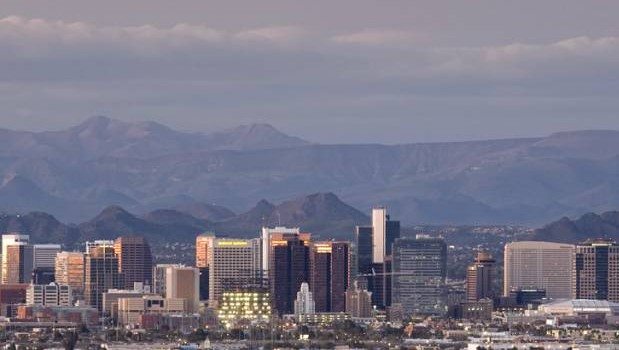Block by block, the Phoenix Metro is seeing reinvestment, redevelopment and repositioning of land, existing buildings and infrastructure. It may not be high tide across the submarkets and sectors, but a rising tide somewhere can still lift a decent number of ships.
The Great Recession has left its mark on the Metro, tasking developers and public entities to do whatever is necessary to meet the demands of Arizona’s present and foreseeable future. Whether that means looking at the Millennial workforce, the K-12 and higher education system, urbanization or infill or attracting large businesses to the state, one thing remains constant — Arizona needs to have a sense of “place.”
Right now, that place is being largely defined by submarkets in the Phoenix Metro. From the largest office development in the Valley — the 2MSF Marina Heights in Tempe — to the comparatively small infill and adaptive reuse projects coming into downtown Phoenix, the commercial real estate industry is developing job corridors, cultural hubs and the multifamily living and transit to connect it all.
A sentiment for responsible development runs through the projects in Arizona’s pipeline; More projects than Ryan Companies Vice President of Development Molly Ryan Carson can reference.
“Responsible development to me is a project that is self sustaining and provides positive attributes to the community in which it resides (employment opportunities, gathering space or amenities that fill a void in that area, green aspects in both the construction/redevelopment and management),” she says.
Industrial and office sectors are seeing large speculative developments come online and multifamily opportunities continue to wait in the wings while thousands of units make their way through the pipeline. One of the leading trends out of nowhereville is adaptive reuse and infill.
Scott Nelson, vice chair of Valley Partnership and vice president of development for Westcor, rattles off a list of projects revitalizing established neighborhoods — Vintage Partners’ redevelopment of Uptown Plaza, Sam Fox’s Yard Concept, Upward Project’s Central Corridor restaurant cluster and similar efforts in downtown Chandler and Gilbert. He calls these catalysts for growth.
“I firmly believe infill development and redevelopment will be a big part of the Valley’s development activity in the coming decades,” says Nelson. “The reinventing and repurposing of land and buildings throughout the region will be an important element to the evolution and maturation of Metropolitan Phoenix. Leveraging and reinvesting in our existing infrastructure – whether it be freeways, light rail, water, waste water, fiber, etc. – along with strategic investment in new and in-place infrastructure will help to ensure smart growth, sustainable economic development, and quality of life.”
Areas where this is taking place, Nelson notes, is downtown Phoenix — through CityScape, the BioSciences Campus — and Tempe — with Discovery Business Campus and Marina Heights.
Phoenix Market President for FirstBank Bryce Lloyd notes that, while this is nothing new, the money will always favor well-located projects, regardless of sector.
“There has been a move toward infill projects, which is a healthy development for the Metro area,” he says. “Everyone can look around and see the success of several of the infill retail/restaurant developments. These projects are having a positive impact on investment and redevelopment activities in the surrounding neighborhoods.”
There is an empty side of infill, though. While municipalities look at ways to reel back unnecessary spending, roads, sewer and water lines have not had the kind of financing and building at prerecession levels.
“One of the most challenging aspects of development today is the creation and maintenance of infrastructure,” says Nelson, adding, “This can be complicated further as we start to see more ‘infill’ developments.”
For infill, developers are reinvesting in existing infrastructure to build a new project. That can be especially expensive, he notes, adding, “I would encourage the state and municipalities to consider alternative financing mechanisms, such as tax increment financing, to be able to successfully maintain existing infrastructure and build new public assets.”
THE GOOD NEIGHBORS
The future of Arizona’s economic recovery is less ephemeral than first believed. In 2013, economists touted 2015 as a year for recovery. Now, they’re saying 2017.
There are a few strains on recovery for Arizona, including a less than favorable reputation, slumping housing market and a strong need for Millennial attraction. Economic development departments are tasked with attracting new businesses to the state and helping existing ones to expand into new spaces. However, even this has been affected by a changing attitude among new and expanding companies, notes Valley Partnership’s Immediate Past Chair and DMB Associates’ Executive Vice President and Chief Entitlements Officer, Karrin Taylor.
“Companies don’t build new offices or lease larger space when they are planning for growth anymore,” she says. “The economic climate has forced businesses to wait until they need the space to make a move. Then, landowners, brokers and cities have to move quickly to respond and take advantage of opportunities.”
When a handful of developers were asked which sectors would see the largest growth over the next 12 months, their answers spanned from medical office buildings to class-A and -B office buildings, low price-point retail, fastcasual restaurants, multifamily, assisted living and industrial.
“As long as there is uncertainty and a sluggish national economy, Arizona’s growth will be restrained,” says Lloyd. “We will probably need to remain patient.”
Lloyd mentions, then, that FirstBank recently closed one of its largest loans to date with fellow Valley Partnership member P.B. Bell on a multifamily property.
“It has taken a little longer than some expected to absorb the commercial space that was overbuilt during the years leading up to the pre-recession, but things are steadily improving,” says Nelson. “The recovery cannot come fast enough for all of us.”
“The slower than anticipated rebound in new home construction permits, a perceived stalling out of the housing recovery and net-new job creation” are strains on Arizona’s economy, says Valley Partnership Board Chair and Evergreen Devco Principal and Chief Operating Officer Doug Leventhal. “Commercial development, particularly retail, lags behind residential growth, so once housing gets back on solid footing, look for an overall improvement in the volume of new commercial development projects.”
So, how do you make Arizona look attractive in a residential slouch?
Make a place appeal to a younger workforce that’s buying into multifamily. That can mean attracting companies where Millennials would like to work, as well as having urban cores that cater to popular and versatile lifestyles.
“The psychological shift of younger workers toward apartment living and renting will continue to impact Phoenix’s market for a while,” adds Taylor. “There’s a generation who saw their friends and parents lose their homes in the downturn and it’s affected their buying decisions. Those multifamily communities are bringing renewed life to downtowns and urban areas around the Valley, especially those areas with a higher concentration of retail and restaurants.”
THE RESPONSIBLE ONES
The bones of Arizona’s recovery are jobs.
“Community wide, our No. 1 focus should be employment,” says Nelson. Employment bases are what drive the need for housing, office and industrial facilities and bring more income to support retail.
“If we are unable to support additional employment and are not competitive to bring additional companies to the state, we are missing a significant pillar to support additional commercial development,” Nelson says.
Broader than employment, Carson adds, Arizona’s economy and the commercial real estate industry is being held back by bad branding.
“Negative press has seemed to rear its head all too frequently in Arizona,” she says. “Any aspect of the economy that is not functioning with all cylinders is at risk for slowing growth; this is the time to band further together and unite around our state’s strengths, and focus on improving in the areas of greatest need.”
DMB Associates’ Taylor agrees.
“Arizona must improve its image nationally to attract and retain businesses. Younger tech workers, engineers, and entrepreneurs want to live in a state where all people are respected and the state projects a positive image,” she says. “As a parent, I want my kids to stay in Arizona and that means that we have great jobs for them when they graduate college and that this is a thriving place of culture and opportunity. Changing our education system requires everyone pulling in the same direction. No more politicizing the process or the conversation; we need to demand results and hold our legislators, teachers, administrators and parents accountable for Arizona’s future.”




